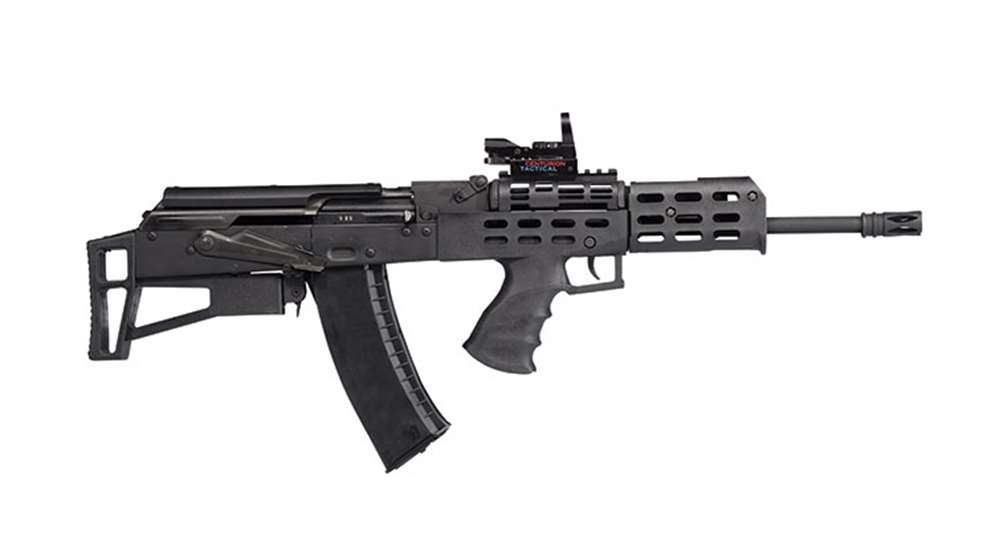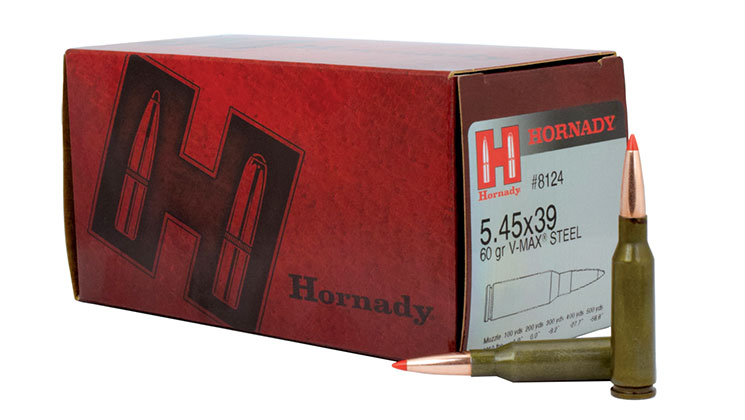
In 1974, a year after I was born, the Soviets placed a peppy .220 caliber-tipped cartridge into military service in their new AK-74 service rifle. It wasn’t random.
Smaller, faster and lighter than the legendary 7.62x39mm cartridge found in the AK-47, the 5.45x39mm in the then-new AK-74 recoiled less and had a flatter trajectory. Furthermore, the Soviet military schetchik bobovs (bean counters) knew they’d be able to give their soldiers more rounds per pound for the same costs for fuel, shipment and delivery. Besproigryshnoy! (Win-Win) The AK-74 rifle itself is—for all intents and purposes—the same rifle mechanically as the much older and wildly successful AK-47, which was the subject of a previous "Can You Hunt With It?" article. The newer, lighter, faster 5.45x39mm cartridge gives the AK-74 more effective range, from 300 to 600 meters.
Is the 5.45x39mm cartridge successful? I’d say so. It outlasted the Soviet Union, and it’s still in service today. As such, scores of AK-74s and their clones have made their way to the United States since 1974.
Why? There are lots of reasons Americans own firearms, but by far, the most popular reason is because we can (and we will). Thus, the only reason anyone may want a 5.45x39mm cartridge-firing rifle is because they want one. Good enough for me, and chances are if you’re reading this story on the American Hunter website, it’s more than good enough for you. Still, there are other reasons to own rifles—notably because you want to hunt with one.
But can, or should, you hunt with an AK-74 and its 5.45x39mm cartridge? Let’s find out!
Before we get into the nitty-gritty details of the 5.45x39mm cartridge, we need to get our minds right. Forget about your typical big-game cartridge, or the AK-47’s 7.62x39mm, .311-inch diameter bullet. Think smaller—much smaller. Imagine people hunting critters in and around our United States with an American cartridge very similar to the pint-sized Soviet slug, the 5.56 NATO, or its kissing cousin, the .223 Remington. Think folks around our great nation hunt with .223s and 5.56 NATOs? Da! In states where it is legal, American hunters have killed scores of critters smaller and larger than they were with them. They’ve done it cleanly, ethically and sometimes dramatically. To be fair, the .223 Remington and 5.56 NATO have had their fair share of wounded animals, too, but the only blame there lies with the shooter—any cartridge can be rendered ineffective if the shooter insists upon it with poor marksmanship or ethics. By the way, now is a great time to point out the Soviet 5.45x39mm fires a .221 caliber bullet, not the .224 caliber bullet found in the .223 Remington and 5.56 NATO.

The 5.45x39mm cartridge was designed by the Soviets to push bullets from 53 grains all the way up to 80 grains. The lighter stuff goes faster, with muzzle velocities of the 53-grain full-metal jacketed stuff going 2900 fps, and the heavy stuff lumbering along at 990 fps. Surplus military ammunition and factory-loaded ammo is available from companies like Russia’s Tula and Barnaul, Ukrainian Red Army Standard (imported by Century Arms International) and as American-as-apple-pie Hornady, which loads an interesting 60-grain V-Max. The Nebraska-built flavor of 5.45x39mm ammo from Hornady leaves the muzzle at about 2810 fps and produces 1,052 ft.-lbs. of energy. In fact, all the loads you can buy globally, surplus or factory, give 5.45x39mm users about the same speeds, plus or minus 2800 to 2900 fps, and between 970 to 1080 ft.-lbs. of energy at the muzzle, minus the heavy 80-grain stuff.
Are the common 53- to 60-grain loads for the 5.45x39mm enough to kill squirrels, skunks, coyotes and other pint-sized critters? Absolyutno! (Absolutely) This is especially true with a varmint-hunting bullet like the V-Max, described by Hornady as a specialized varmint bullet designed for dramatic expansion and explosive fragmentation at a wide range of distances and velocities.
Are these same loads enough for ethical kills of deer, black bears, elk and antelope? Probably not. Why not? It’s not because the speed isn’t there, it’s because there just aren’t that many big-game hunting bullets available for the 5.45x39mm, even for hand loaders—and that’s not because the world’s big game bullet manufacturers forgot about the Soviet design. Hint, hint. Just to give you some perspective, Sierra makes four GameKing bullets, which the company describes as “designed for a combination of penetration and expansion in medium and heavy game animals for their calibers” for the .224, and nothing, not even match or varmint bullets in the .221 size. Again—hint, hint.
In the end, to me, a hunting discussion about the 5.45x39mm cartridge should probably include tales of predator calls, yips, squirrel stew and maybe a few foxes with a bad case of chicken breath; but I don’t think deer camp is the best place for an AK-74. Well, unless your camp chef is so good you need to post a guard. Then, an AK-74 and its feisty 5.45x39mm cartridge is a mighty fine choice.
Looking for previous installments of "Can You Hunt With It?" We've got you covered.
• Heckler & Koch HK45
• Model 1896 Swedish Mauser
• AK-47




































